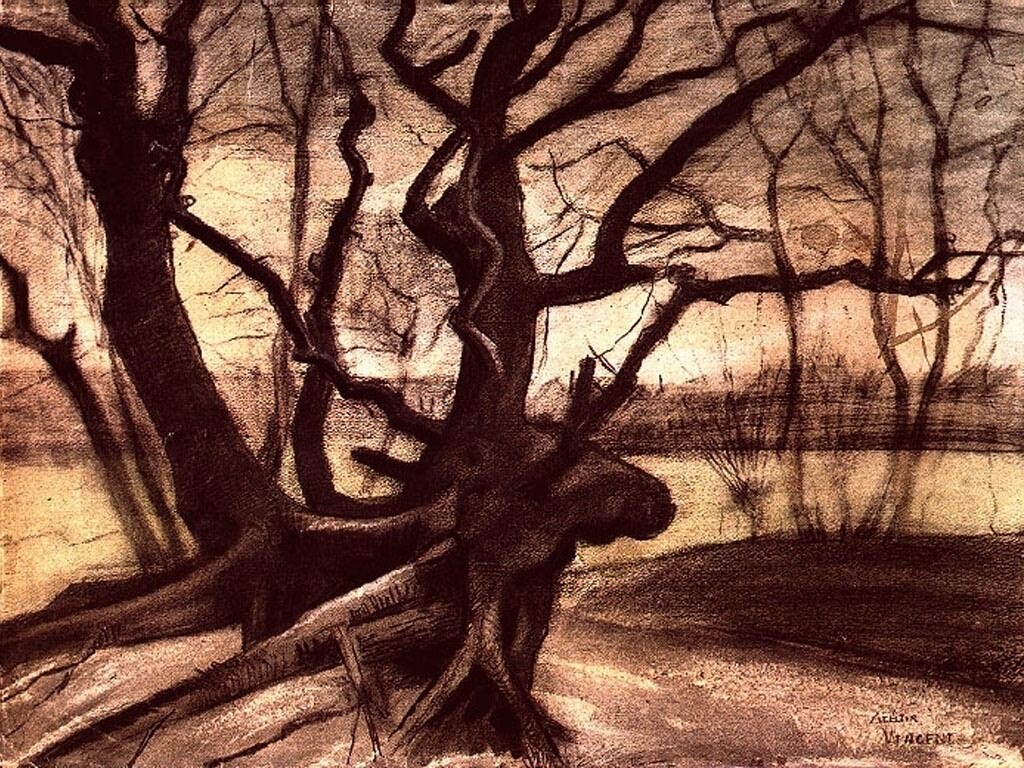Study of a Tree (Tree Roots in a Sandy Ground ("Les Racines"))
Appreciation

Study of a Tree Nederland Vincent van Gogh Gallery and Appreciation
This watercolour was previously known by the title Study of a Tree (see both the 1970 De la Faille catalogue raisonn├® and the 1996 Hulsker catalogue raisonn├®). The Kr├Čller-M├╝ller Museum, however, has given this watercolour a title taken from Van Gogh's own letters (see below). "Les Racines" is French for "The Roots" and Van Gogh was writing to his brother Theo from The Hague in French.
In 1882 Vincent van Gogh was living in The Hague with Clasina Maria Hoornik (known as Sien). Their relationship was a turbulent one and would ultimately end in separation. It's certainly possible that Van Gogh himself was experiencing raw and unhappy emotions at the time he produced this specific work. The following excerpt from a 1 May 1882 letter to Theo supports this assumption:
IŌĆÖve now finished two larger drawings. First of all, Sorrow, but in a larger format, the figure alone without surroundings. But the pose has been altered somewhat, the hair doesnŌĆÖt hang down the back but to the front, part of it in a plait. This brings the shoulder, the neck and back into view. And the figure has been drawn with more care.
The other one, ŌĆśRootsŌĆ? is some tree roots in sandy ground. IŌĆÖve tried to imbue the landscape with the same sentiment as the figure.
Frantically and fervently rooting itself, as it were, in the earth, and yet being half torn up by the storm. I wanted to express something of lifeŌĆÖs struggle, both in that white, slender female figure and in those gnarled black roots with their knots. Or rather, because I tried without any philosophizing to be true to nature, which I had before me, something of that great struggle has come into both of them almost inadvertently. At least it seemed to me that there was some sentiment in it, though I may be mistaken, anyway, youŌĆÖll have to see for yourself.
(Letter 195)
In a second letter to Theo written one day later Van Gogh mentioned another version of "Les Racines" which he completed in one sitting. Van Gogh scholar Teio Meedendorp believes that the drawing Van Gogh mentions in his first letter (above) is the one in the Kr├Čller-M├╝ller collection--in part because it's unlikely that a watercolour of such complexity could have been completed in a single sitting.
Van Gogh was no doubt very pleased with the final outcome of this watercolour. Note the signature: "Atelier Vincent." In Van Gogh's drawings, watercolours and paintings he would only sign those works that he was most proud of. Van Gogh had a critical eye of his own works and would only sign 22% of his drawings and watercolours. In this specific watercolour the signature "Atelier Vincent" was an appellation that Van Gogh would use rarely--only ten times in all of his 1,098 drawings and watercolours.
It's clear from the superb execution of this watercolour that Van Gogh's career as a expert draughtsman was well underway.